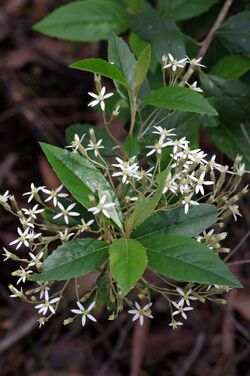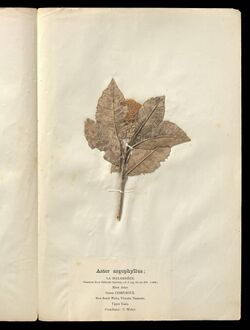Biology:Olearia argophylla
| Musk daisy-bush | |
|---|---|

| |
| Olearia argophylla | |
| Scientific classification | |
| Kingdom: | Plantae |
| Clade: | Tracheophytes |
| Clade: | Angiosperms |
| Clade: | Eudicots |
| Clade: | Asterids |
| Order: | Asterales |
| Family: | Asteraceae |
| Genus: | Olearia |
| Species: | O. argophylla
|
| Binomial name | |
| Olearia argophylla (Labill.) F.Muell. ex Benth.[1]
| |

| |
| Synonyms[1] | |
| |

Olearia argophylla, commonly known as musk daisy-bush, native musk or silver shrub,[3] is a species of flowering plant in the family Asteraceae and is endemic to south-eastern Australia. It is a shrub or tree with silvery branchlets, egg-shaped to elliptic leaves, and white and yellow, daisy-like inflorescences.
Description
Olearia argophylla is a shrub or tree that typically grows to a height of up to about 10 m (33 ft), and has fissured to slightly stringy or flaky bark. Its branchlets are densely covered with fine, silvery or pale brown hairs pressed against the surface. The leaves are arranged alternately, egg-shaped to broadly elliptic, mostly 30–120 mm (1.2–4.7 in) long and 20–70 mm (0.79–2.76 in) wide on a petiole up to 25 mm (0.98 in) long, and have toothed edges. The upper surface of the leaves is glabrous and the lower surface covered with minute, woolly, white or silvery hairs.[3][4][5]
The heads are 13–27 mm (0.51–1.06 in) wide and arranged in corymbs on the ends of branchlets, each corymb on a peduncle up to 20 mm (0.79 in) long. Each head or daisy-like "flower" has three to eight white ray florets, the petal-like ligule 4–10 mm (0.16–0.39 in) long, surrounding three to eight yellow disc florets. Flowering mainly occurs from September to February and the fruit is a straw-coloured or pinkish achene 2.5–4.0 mm (0.098–0.157 in) long, the pappus with 26–43 bristles about 5 mm (0.20 in) long.[3][4][5]
Taxonomy
Musk daisy-bush was first formally described in 1806 by Jacques Labillardière who gave it the name Aster argophyllus in his book Novae Hollandiae Plantarum Specimen.[6][7] In 1867, George Bentham changed the name to Olearia argophylla in Flora Australiensis.[8]
In 1825, Henri Cassini changed Labillardière's name Aster argophyllus to Eurybia argophylla in Frédéric Cuvier's Dictionnaire des Sciences Naturelles[9][10] but this name is considered a synonym by the Australian Plant Census.[1]
Distribution and habitat
Olearia argophylla commonly grows on cool moist sheltered slopes and in fern gullies in taller eucalypt forests south from the Whian Whian State Conservation Area in eastern New South Wales, the Australian Capital Territory, through most of eastern Victoria apart from the Grampians to Tasmania where it is common and widespread.[3][4][11]
Use in horticulture
Olearia argophylla can be propagated from seed or from cuttings. It prefers partial to full shade in soils that are neutral or slightly acidic, and is frost tolerant.[12]
References
- ↑ 1.0 1.1 1.2 "Olearia argophylla". Australian Plant Census. https://biodiversity.org.au/nsl/services/apc-format/display/103464.
- ↑ Australia, National Museum of (1875-01-01). "Aster Argophyllus" (in en). http://collectionsearch.nma.gov.au/object/112571.
- ↑ 3.0 3.1 3.2 3.3 Lander, Nicholas S.. "Olearia argophylla". Royal Botanic Garden Sydney. https://plantnet.rbgsyd.nsw.gov.au/cgi-bin/NSWfl.pl?page=nswfl&lvl=sp&name=Olearia~argophylla.
- ↑ 4.0 4.1 4.2 Walsh, Neville G.; Lander, Nicholas S.. "Olearia argophylla". Royal Boatanic Gardens Victoria. https://vicflora.rbg.vic.gov.au/flora/taxon/5798ceae-70e7-48fb-b9b4-8d019dff15bc.
- ↑ 5.0 5.1 Wood, Betty. "Oleaaria argophylla". Lucid Keys. https://apps.lucidcentral.org/plants_se_nsw/text/entities/olearia_argophylla.htm.
- ↑ "Aster argophyllus". https://biodiversity.org.au/nsl/services/rest/name/apni/536903/api/apni-format. Retrieved 22 February 2022.
- ↑ Labillardière, Jacques (1806). Novae Hollandiae Plantarum Specimen. 2. Paris. p. 52. https://www.biodiversitylibrary.org/page/40882055#page/52/mode/1up. Retrieved 22 February 2022.
- ↑ "Olearia argophyllus". https://biodiversity.org.au/nsl/services/rest/name/apni/532024/api/apni-format. Retrieved 22 February 2022.
- ↑ "Eurybia argophylla". https://biodiversity.org.au/nsl/services/rest/name/apni/24335/api/apni-format. Retrieved 22 February 2022.
- ↑ Cassini, Henri (1825). Dictionnaire des Sciences Naturelles. 37 (2 ed.). p. 487. https://www.biodiversitylibrary.org/item/81570#page/493/mode/1up. Retrieved 22 February 2022.
- ↑ Jordan, Greg. "Olearia argophylla". University of Tasmania. https://www.utas.edu.au/dicotkey/dicotkey/AST/ast/sOlearia_argophylla.htm.
- ↑ "Olearia argophylla". https://www.yarraranges.vic.gov.au/PlantDirectory/Trees/Trees-3-25m/Olearia-argophylla.
| Wikimedia Commons has media related to Olearia argophylla. |
Wikidata ☰ Q2160632 entry
 |

